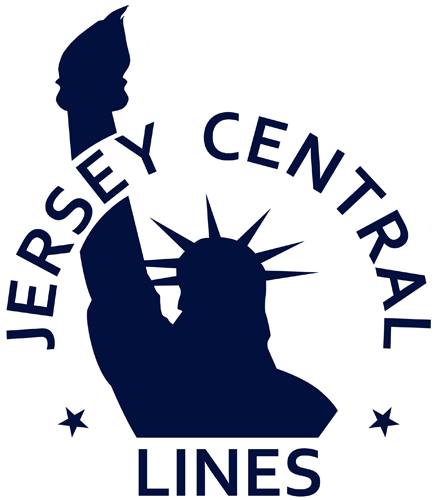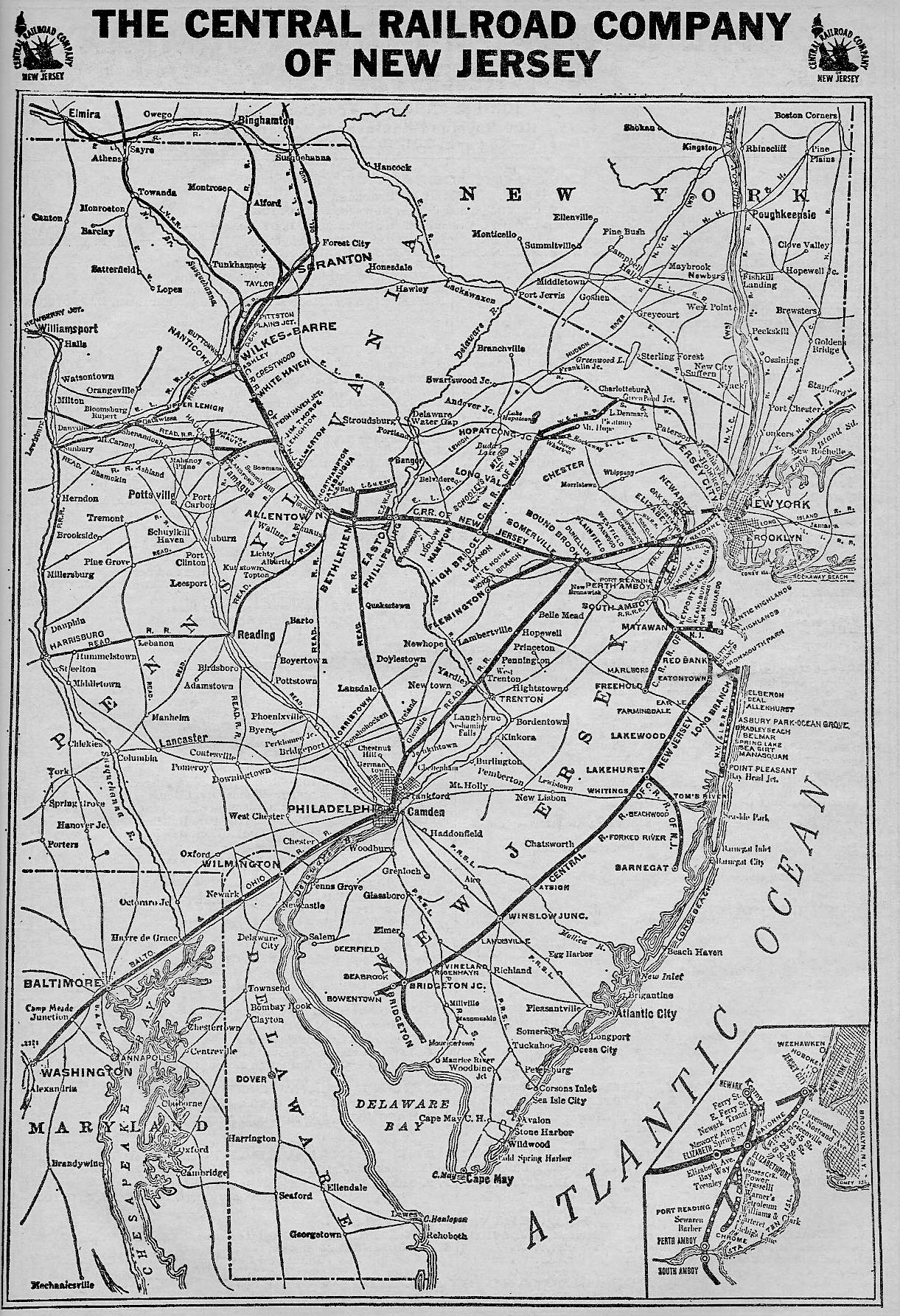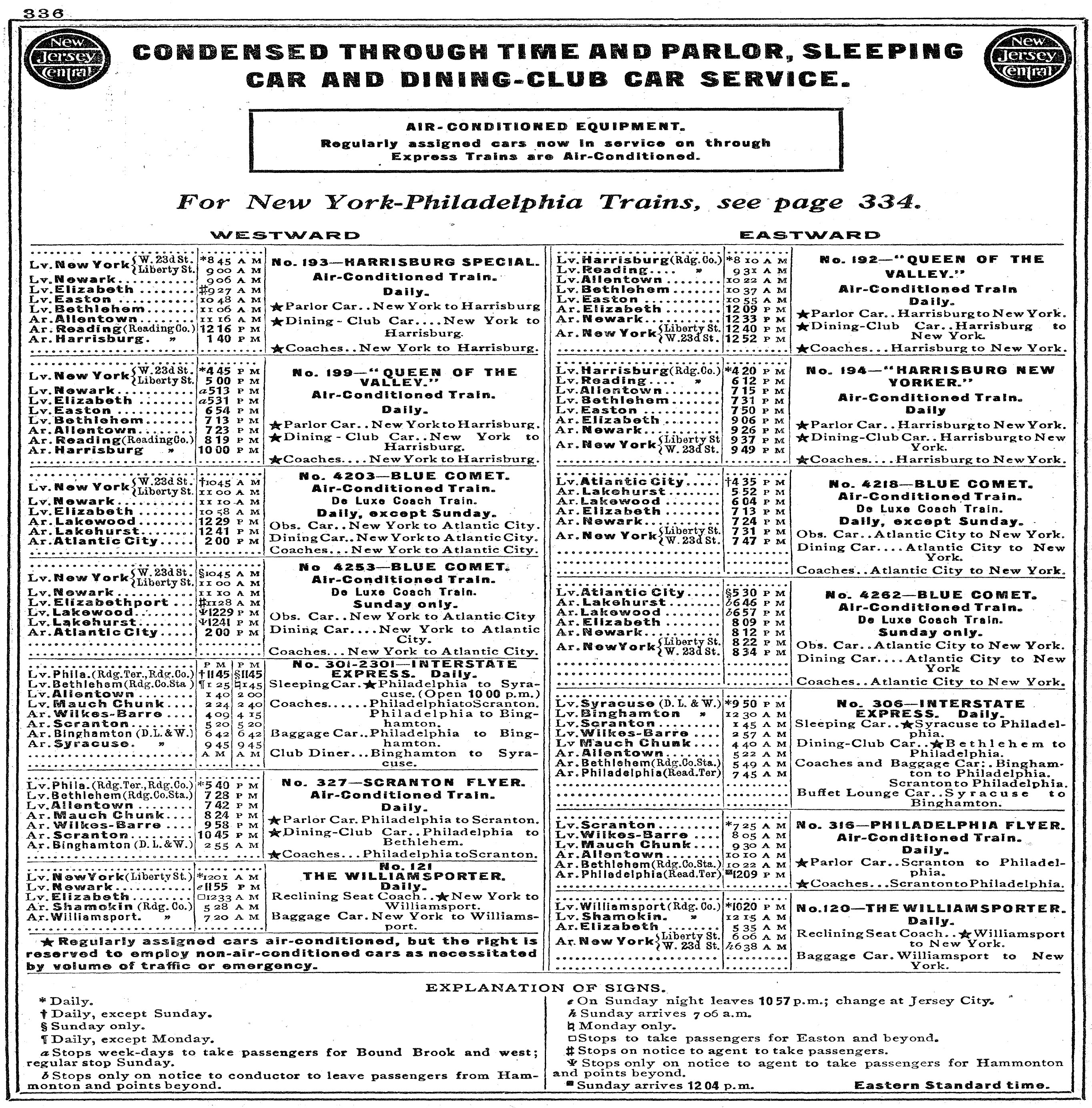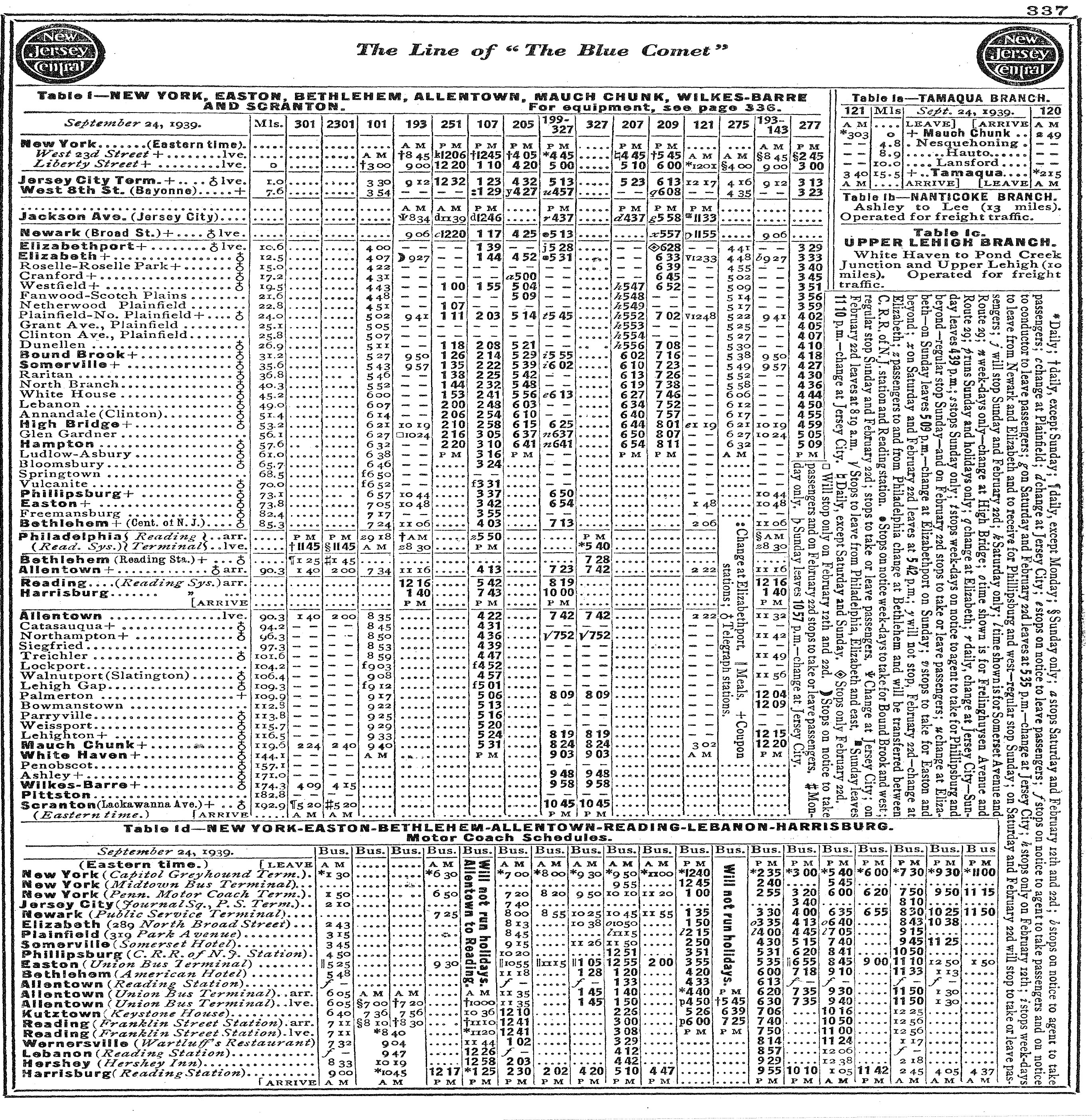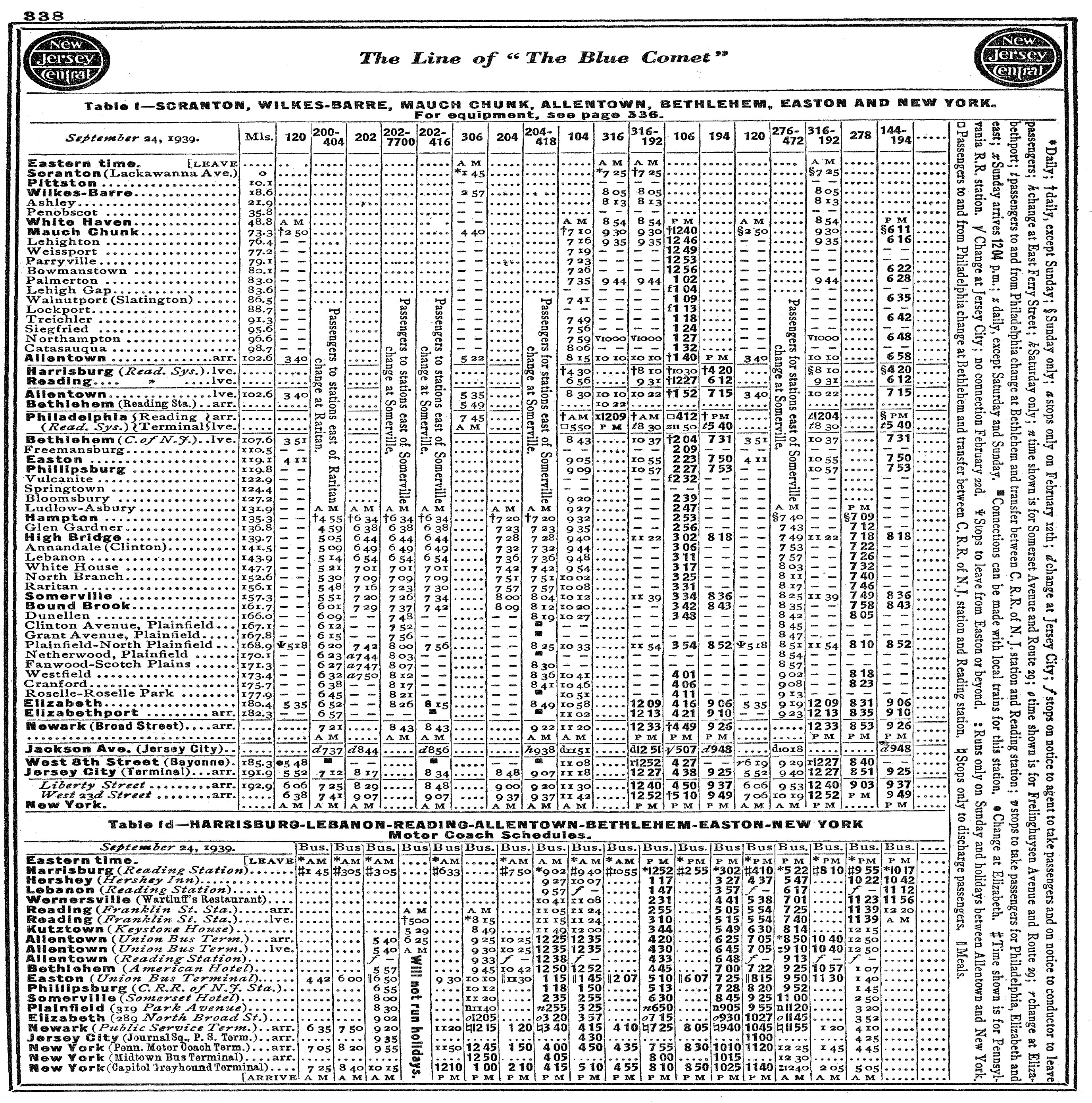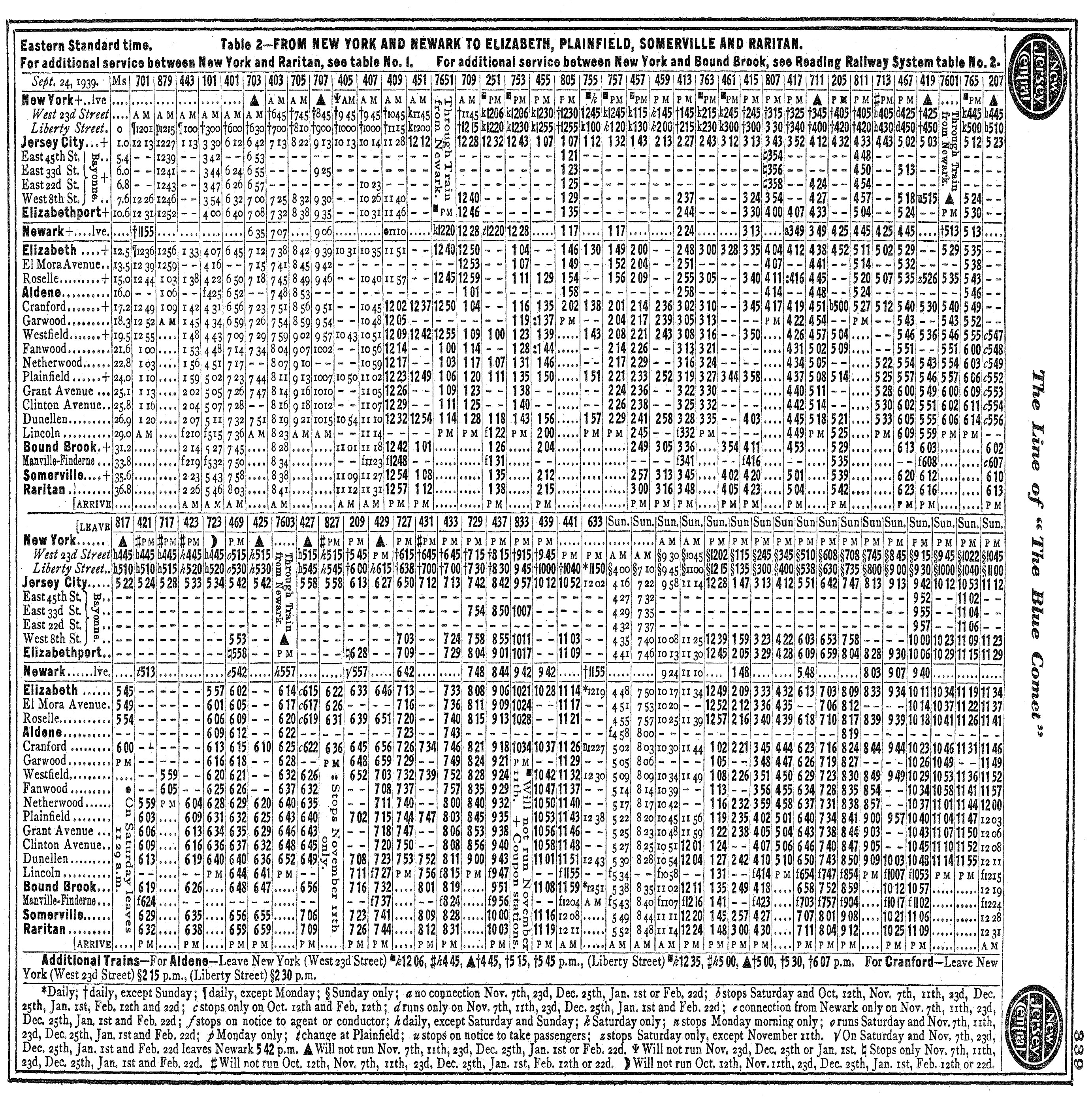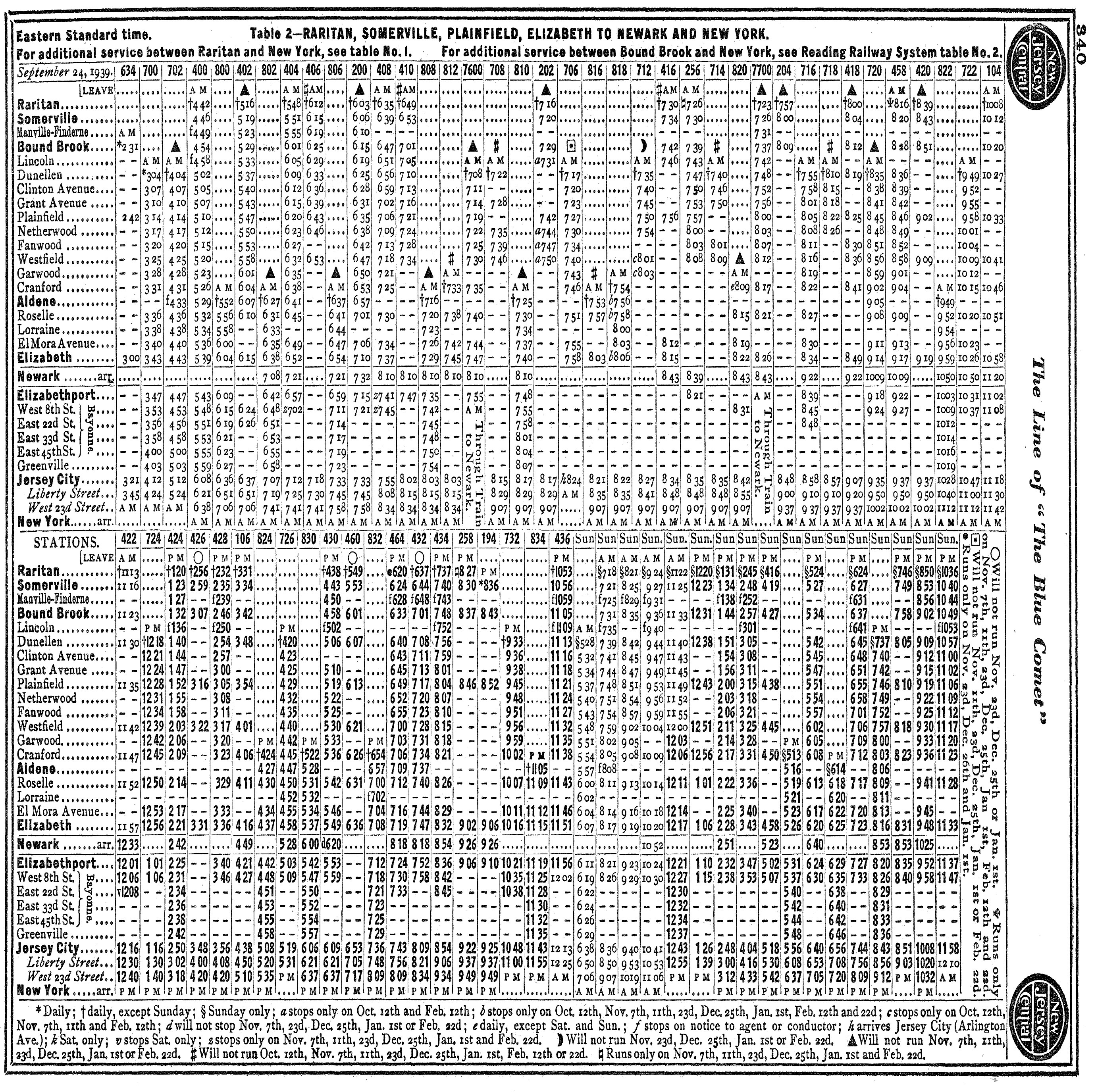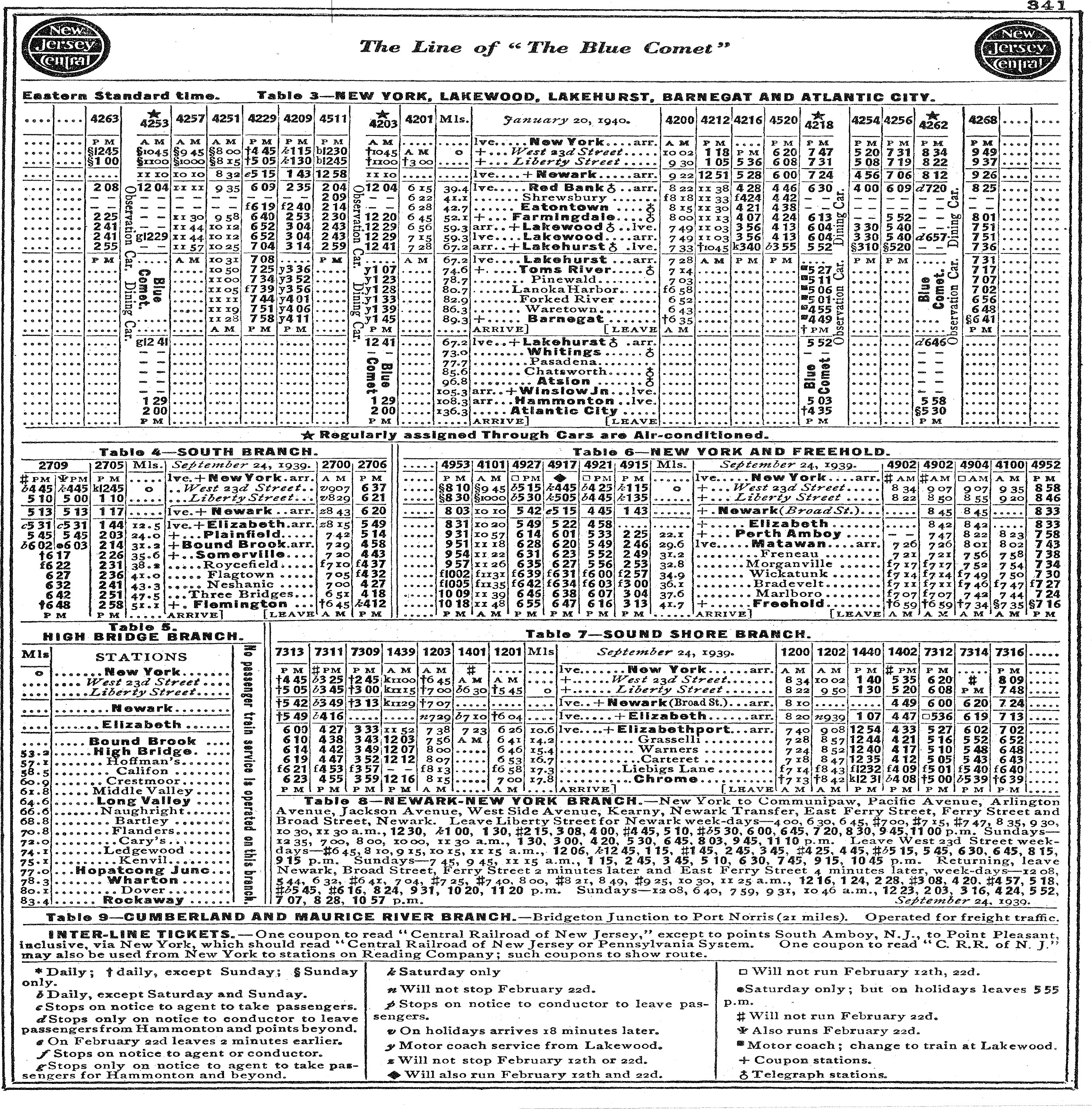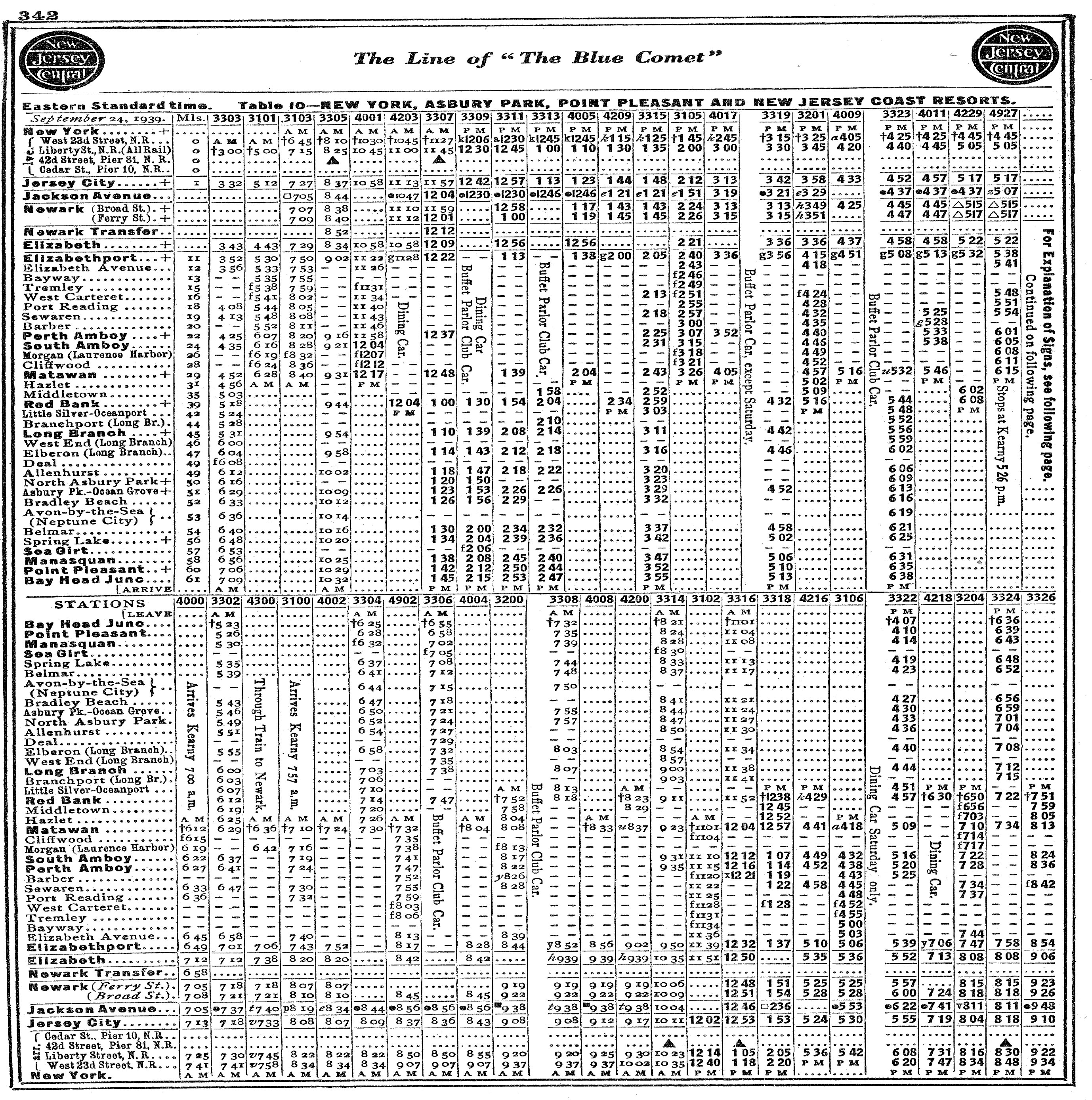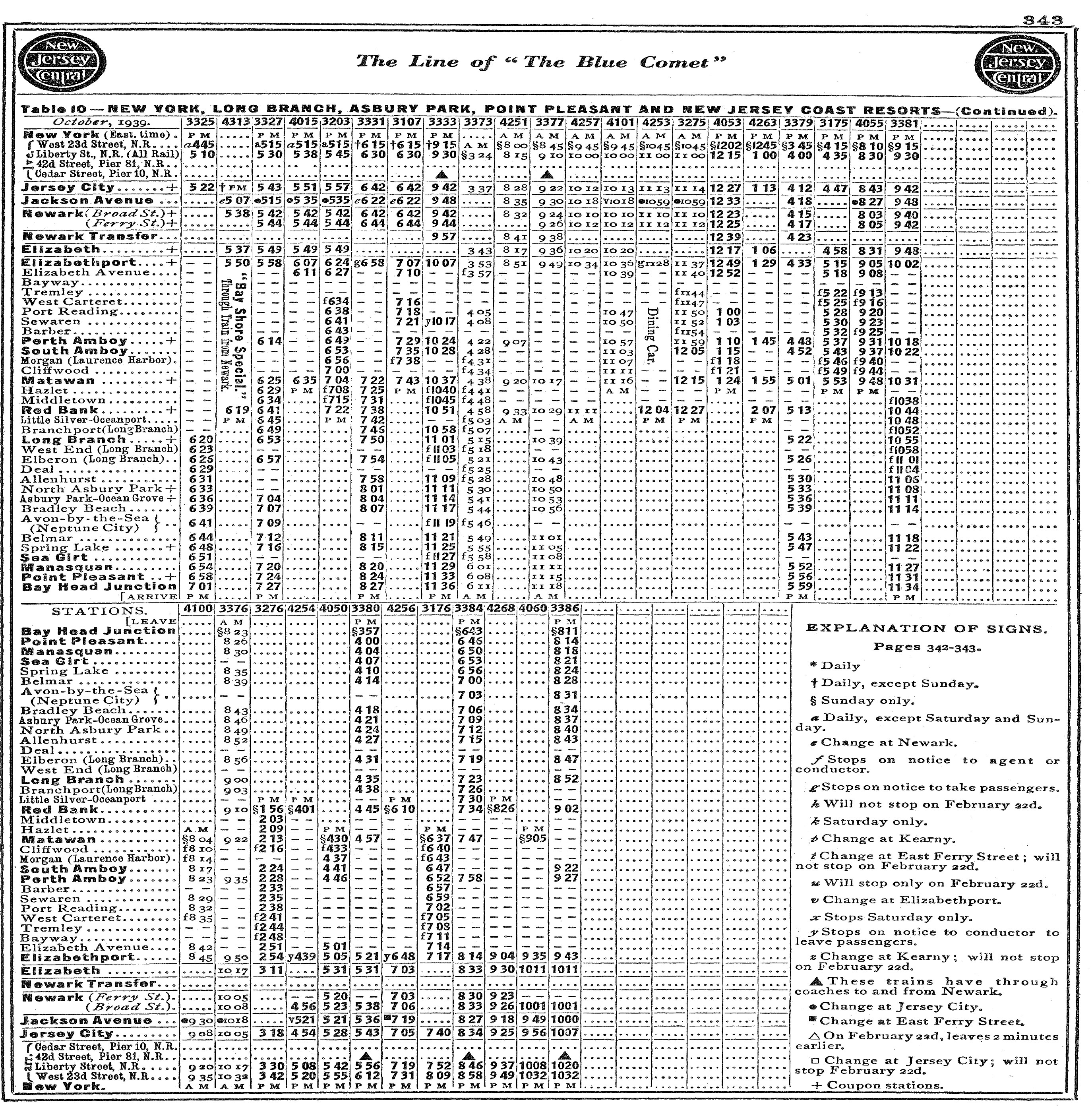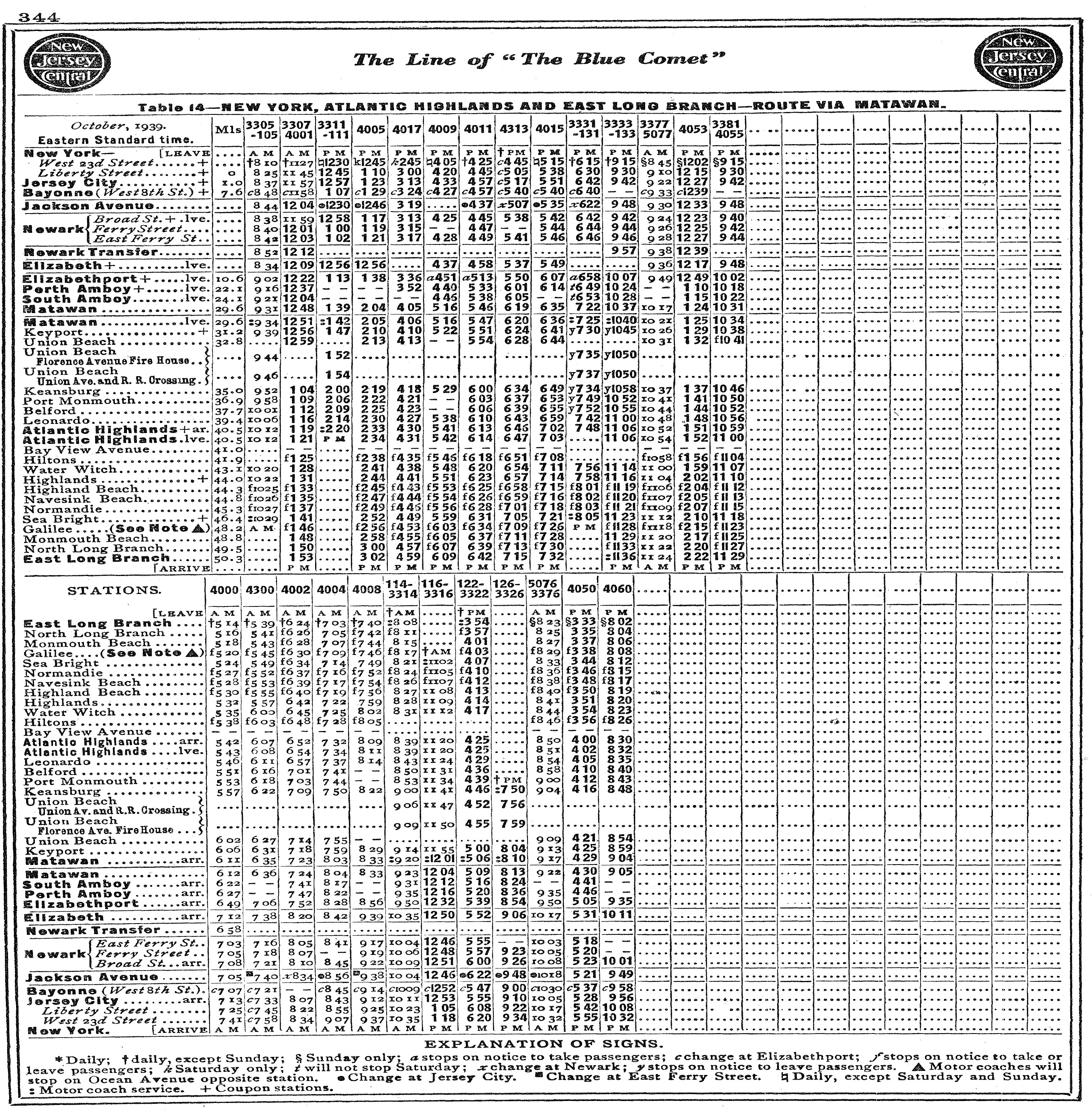Jersey Central Railroad (CNJ): Map, Rosters, History
Last revised: November 22, 2024
By: Adam Burns
The Central Railroad of New Jersey has gone by a number of different names from CNJ to Jersey Central, and the aforementioned moniker.
Regardless of its many titles the CNJ was a New Jersey institution although it was only regional in operation and, at its peak, just 711 miles in length.
The Jersey Central served much of its home state along with northwestern Pennsylvania, including Easton, Bethlehem, and Wilkes-Barre. It also acquired a part of the old Lehigh & New England during the 1960s to pick up desperately need freight tonnage.
The demise of the CNJ was the result of several factors including a region too saturated with railroads, stiff government regulation, and markets already served by more efficient competitors (such as the Pennsylvania and Reading).
However, for all of these setbacks the railroad was further burdened by heavy taxation through the state of New Jersey.
These issues ultimately led to the railroad’s bankruptcy and inclusion into Conrail in 1976. Today, little remains of the old Jersey Central lines, many of which have been abandoned across its home state and eastern Pennsylvania.
Photos
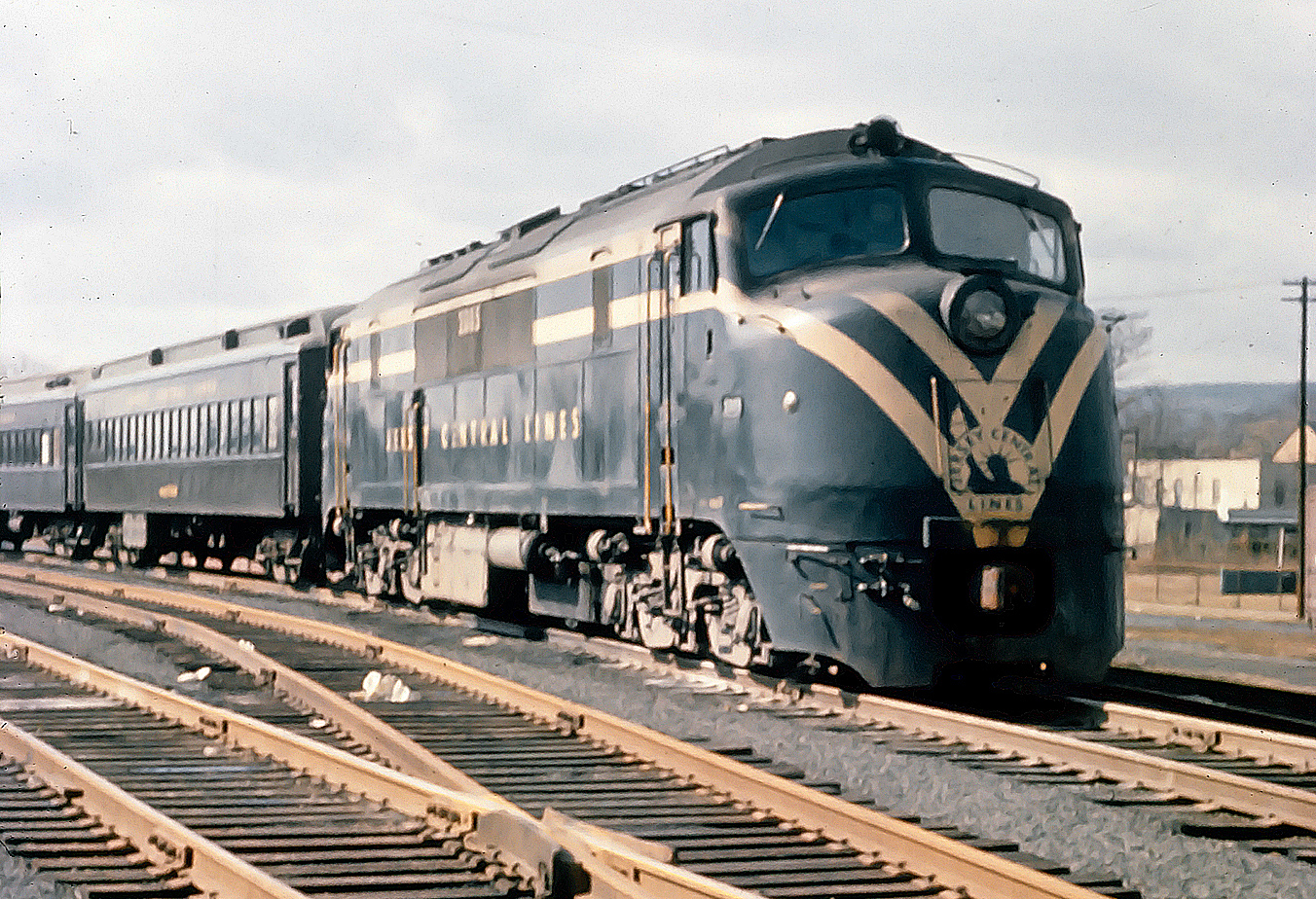 One of the Jersey Central's double-ended DRX-6-4-2000's, #2005, is seen here tied down in Plainfield, New Jersey, circa 1955. The units were acquired by the CNJ for commuter service to eliminate turning the locomotives at the Hudson River waterfront in Jersey City, New Jersey (Communipaw Terminal). Meyer Pearlman photo. American-Rails.com collection.
One of the Jersey Central's double-ended DRX-6-4-2000's, #2005, is seen here tied down in Plainfield, New Jersey, circa 1955. The units were acquired by the CNJ for commuter service to eliminate turning the locomotives at the Hudson River waterfront in Jersey City, New Jersey (Communipaw Terminal). Meyer Pearlman photo. American-Rails.com collection.History
The Central Railroad of New Jersey has a complicated and complex corporate history comprising numerous predecessors and subsidiaries which later came together to form the classic CNJ system.
During the 19th century and into the early 20th, prior to the development of efficient highways, the railroad enjoyed a robust and healthy business.
It lay in the busiest and most densely populated region in the country, moving thousands of commuters daily while a diverse traffic based handled everything from oil to milk.
The Jersey Central's earliest ancestry comprised two notable systems; the Elizabethtown & Somerville, incorporated on February 9, 1831, and the Somerville & Easton, incorporated in 1847.
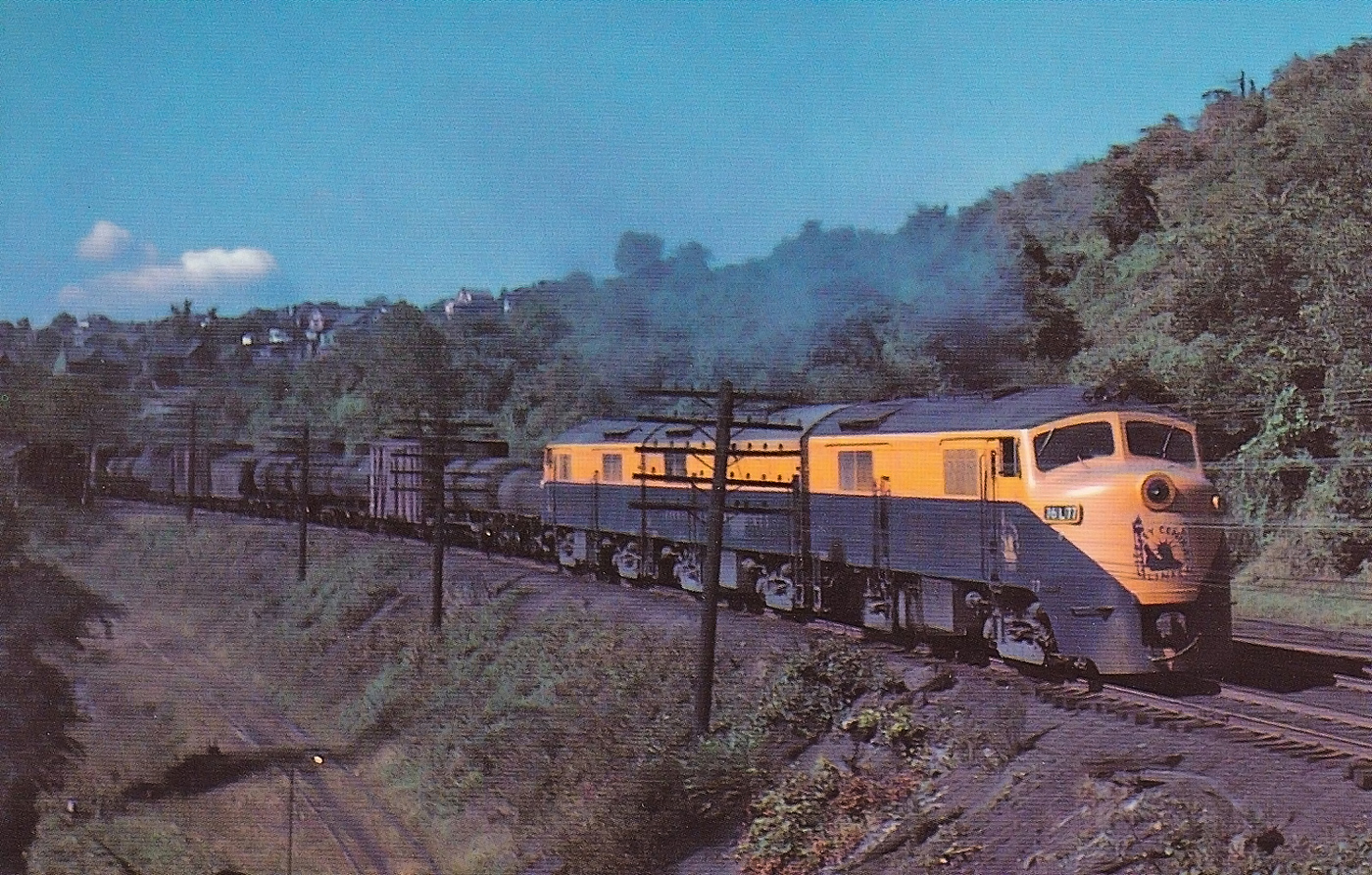 An A-B-A set of Jersey Central DR-4-4-1500's are ahead of a mixed freight at the once important industrial city and interchange point of Phillipsburg, New Jersey in the fall of 1948. John Maris photo.
An A-B-A set of Jersey Central DR-4-4-1500's are ahead of a mixed freight at the once important industrial city and interchange point of Phillipsburg, New Jersey in the fall of 1948. John Maris photo.The E&S took some time to get under way but finally did so on August 13, 1836 when it opened roughly 2 miles between Elizabeth and Elizabethport along the mouth of the Arthur Kill (until 1864 the CNJ operated ferry service between Elizabethport and New York City).
At the time trains were only horse-drawn; steam power did not arrive until January 1, 1839 when the system had reached Plainfield.
Finally, on January 2, 1842 service extended to Somerville, completing the road's original charter. The Somerville & Easton began construction soon after its incorporation, opening between Somerville and White House on September 25, 1848.
The creation of the CNJ was a result of the S&E acquiring the E&S, changing the name of both as the Central Railroad Company of New Jersey on April 23, 1849. Like most of the now-classic fallen flags, the CNJ expanded and grew through a combination of new construction and take over of smaller lines.
At A Glance
Jersey City - Elizabeth - Phillipsburg, New Jersey Easton - Bethlehem - Allentown - Wilkes-Barre/Scranton, Pennsylvania High Bridge - Hopatcong Junction - Rockaway, New Jersey Newark - Perth Amboy - South Amboy - Matawan - Red Bank, New Jersey Freehold - Matawan - Highlands, New Jersey Red Bank - Bowentown, New Jersey Lakehurst - Barnegat, New Jersey | |
Soon after the name change the new company continued pushing rails west until it had spanned its home state, opening service to Phillipsburg in 1852.
This town grew into an important commercial center where five major railroads once met; including the CNJ these were the Lehigh & Hudson River; Lehigh Valley; Delaware, Lackawanna & Western; and Pennsylvania Railroad's Belvidere Division.
Logo
Pushing rails beyond Elizabethport to the Hudson River took a bit more work. However, doing so would offer the CNJ nearly-direct service into Manhattan, albeit requiring ferries to do so.
In 1864 it completed an extension across the Newark Bay, via a one-mile long bridge to Jersey City where a small terminal was opened at what is today Liberty State Park.
The facility, referred to as Communipaw Terminal, or Jersey City Terminal, was replaced with a much larger station in 1889 that served as one of the major Hudson River terminals until the postwar period. It was not only the CNJ's primary terminal into New York but also handled the trains of Reading and Baltimore & Ohio.
The completion of the railroad's Jersey City connection constituted its "Central Division" from that point to Phillipsburg. It was the busiest component of the CNJ and carried four to six tracks along the 35-mile corridor between Jersey City and Raritan.
According to the Classic Trains article, "Jersey Central: Coal, Commuters, And A Comet," this high-speed thoroughfare witnessed 300 commuter trains daily, carrying 35,000 riders, in addition to local freights which the railroad referred to as "drills." There were two other major divisions of the CNJ, which will be briefly highlighted below.
System Map (1969)
Southern Division
The Jersey Central's Southern Division, as its name implies, operated into the state's sparsely-populated southern regions (the so-called, "Pine Barrens") from Red Bank to Bridgeton/Bowentown/Bayside.
During its heyday the trackage handled a variety of freight from agriculture to aggregates. It also moved commuters and vacationers to locations such as Atlantic City, Long Branch, and Tuckerton. The largest component of the Southern Division was the Raritan & Delaware Bay Railroad chartered in 1854.
It was originally intended to link New York with the important Virginia port of Norfolk, via steamship service across the Delaware Bay. While this plan ultimately never materialized the system did construct a significant stretch of trackage across New Jersey.
It opened its first segment in 1860 between Port Monmouth and Bergen Iron Works (Lakewood) via Red Bank. Thanks to a relatively flat topography, grading and construction commenced quickly and by 1862 had reached Winslow where a connection was made with the Camden & Atlantic offering through service to Camden, New Jersey.
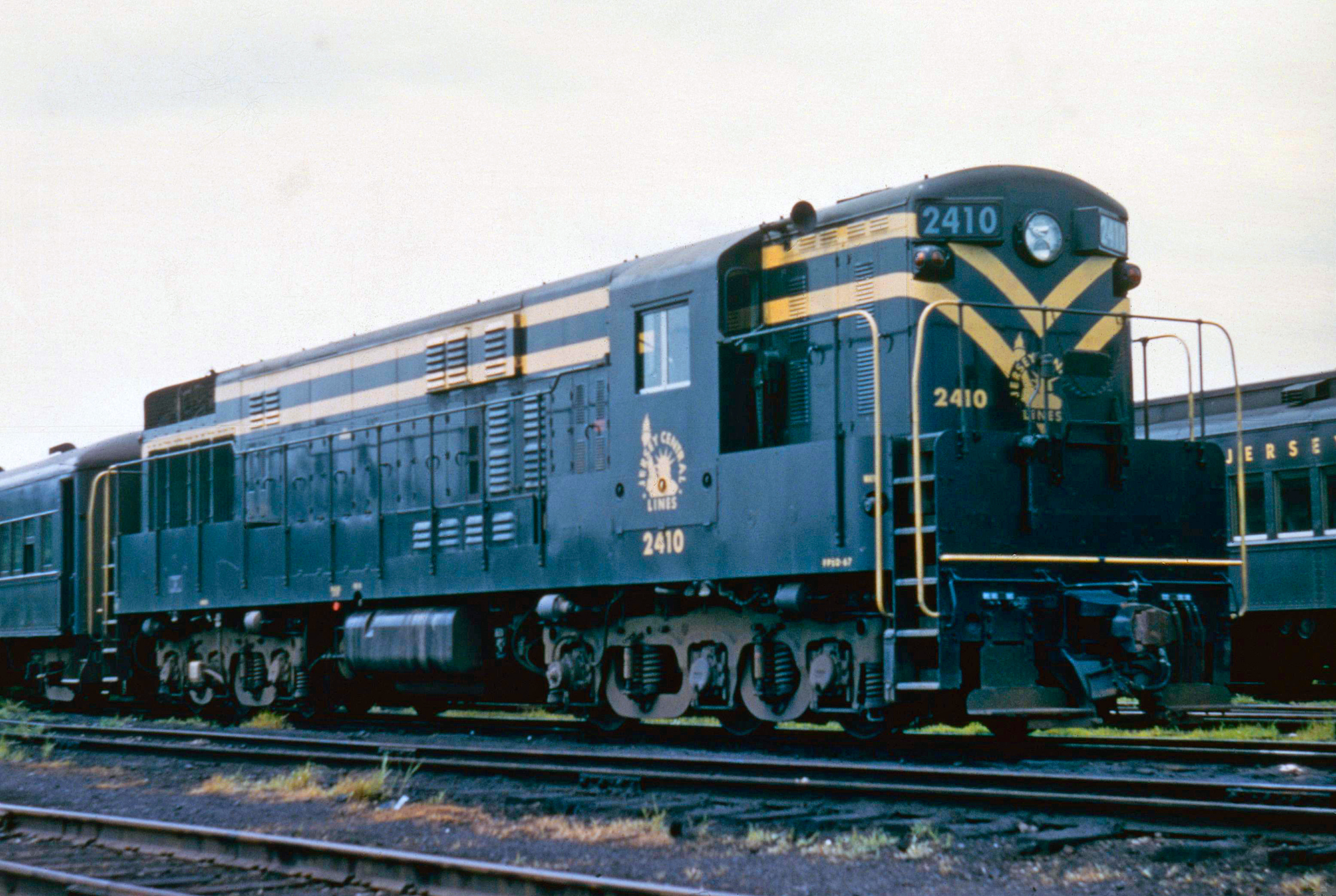 A handsome Jersey Central "Train Master," #2410, rests between commuter assignments along the New York & Long Branch at Bay Head Junction, New Jersey on July 15, 1956. Author's collection.
A handsome Jersey Central "Train Master," #2410, rests between commuter assignments along the New York & Long Branch at Bay Head Junction, New Jersey on July 15, 1956. Author's collection.In 1870 the R&DB was renamed as the New Jersey Southern Railroad (later reorganized as the New Jersey Southern Railway in 1880) and extensions beyond Winslow were the result of acquiring the Vineland Railway in 1872 (via lease), which had opened to Bayside in 1871.
The completion of this line constituted the extent of the Southern Division's main line although there were branches later added to the network reaching Tuckerton/Barnegat, Deerfield, and Bivalve while carferry service was established to Woodland Beach, Delaware via Bayside.
Arguably the most important segment of the Southern Division was the New York & Long Branch Railroad, chartered on April 8, 1868. The line's construction did not begin for some time although the CNJ already held a controlling interest by 1873.
The NY&LB connected the Central's northern New Jersey lines with the NJS properties to the south. It opened for service between Perth Amboy and Long Branch in 1875, eventually extending southward to Bay Head Junction by 1882.
The NY&LB proved a major commuter corridor within a quickly expanding region and rival Pennsylvania Railroad wanted in; it launched plans to build a competing line but ultimately the two roads agreed to mutually share the NY&LB in January of 1882 with the CNJ handling freight duties.
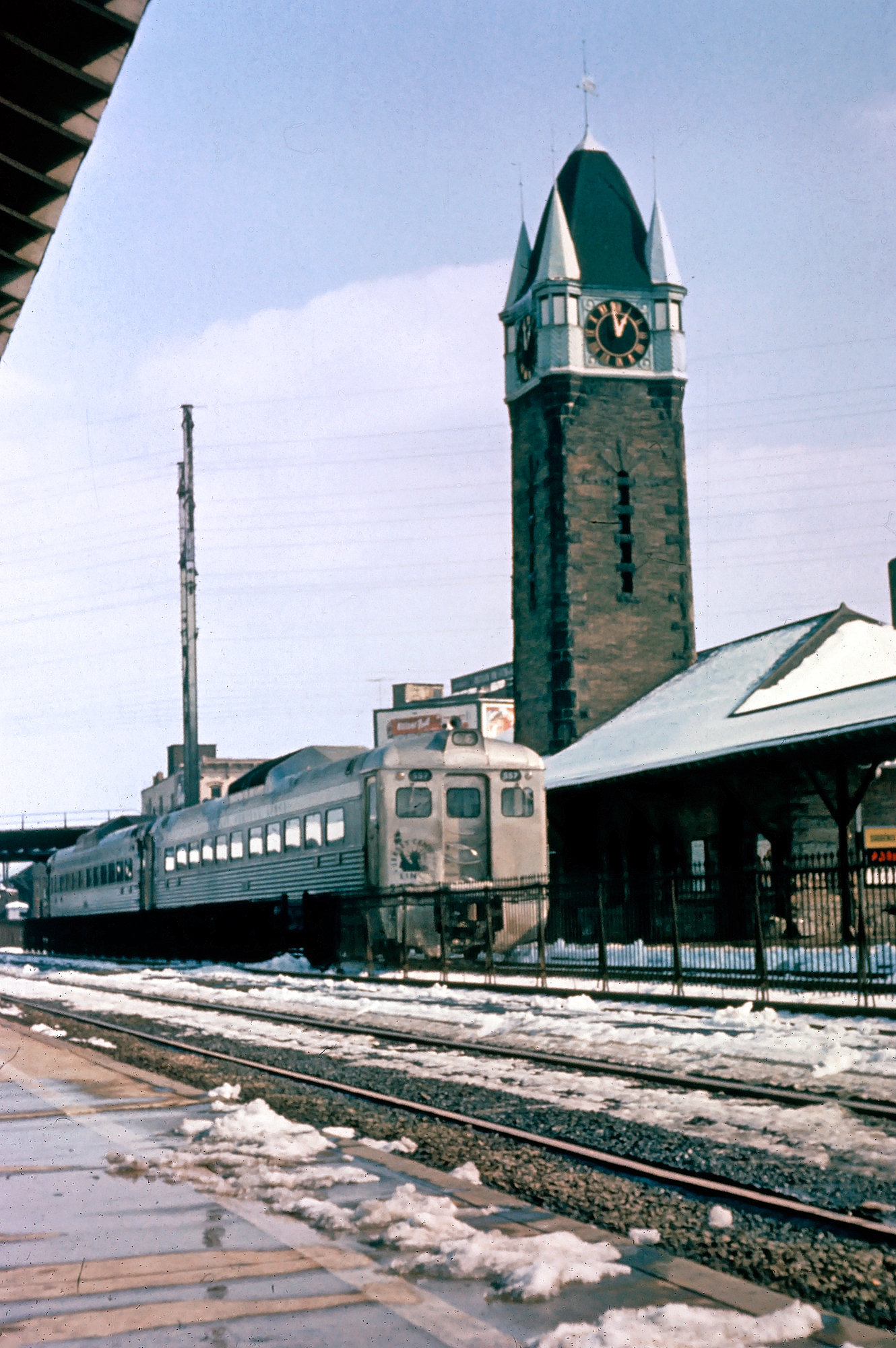 Jersey Central RDC-1s work local service on the four-track main line at Elizabeth, New Jersey, circa 1960. The Pennsylvania Railroad's Northeast Corridor can be seen in the background. Meyer Pearlman photo. American-Rails.com collection.
Jersey Central RDC-1s work local service on the four-track main line at Elizabeth, New Jersey, circa 1960. The Pennsylvania Railroad's Northeast Corridor can be seen in the background. Meyer Pearlman photo. American-Rails.com collection.Lehigh & Susquehanna Division/Pennsylvania Division
The Jersey Central's trackage within Pennsylvania, west of Easton, was known by different names over the years, first as the Lehigh & Susquehanna Division and then later the Pennsylvania, or Penn Division. The territory was the road's vitally important freight corridor, earning it the status of an anthracite carrier.
The division's original moniker was derived from a railroad of the same name, the Lehigh & Susquehanna, founded in 1837 as a component of the Lehigh Coal & Navigation Company.
It opened for service in 1843, moving anthracite coal from the Lehigh Canal at White Haven to Wilkes-Barre situated along the North Branch Canal.
The road was slowly extended southward from White Haven over the years reaching Mauch Chunk (later renamed Jim Thorpe) in 1867 and finally Phillipsburg in 1868.
In 1871 the CNJ formally leased the L&S and in the subsequent years added many branches to tap additional mines reaching locations such as Lehigh, Lee, Nanticoke, and Audenreid. Its last notable extension occurred with the opening of the Wilkes-Barre & Scranton in 1888 between Pittston and Scranton.
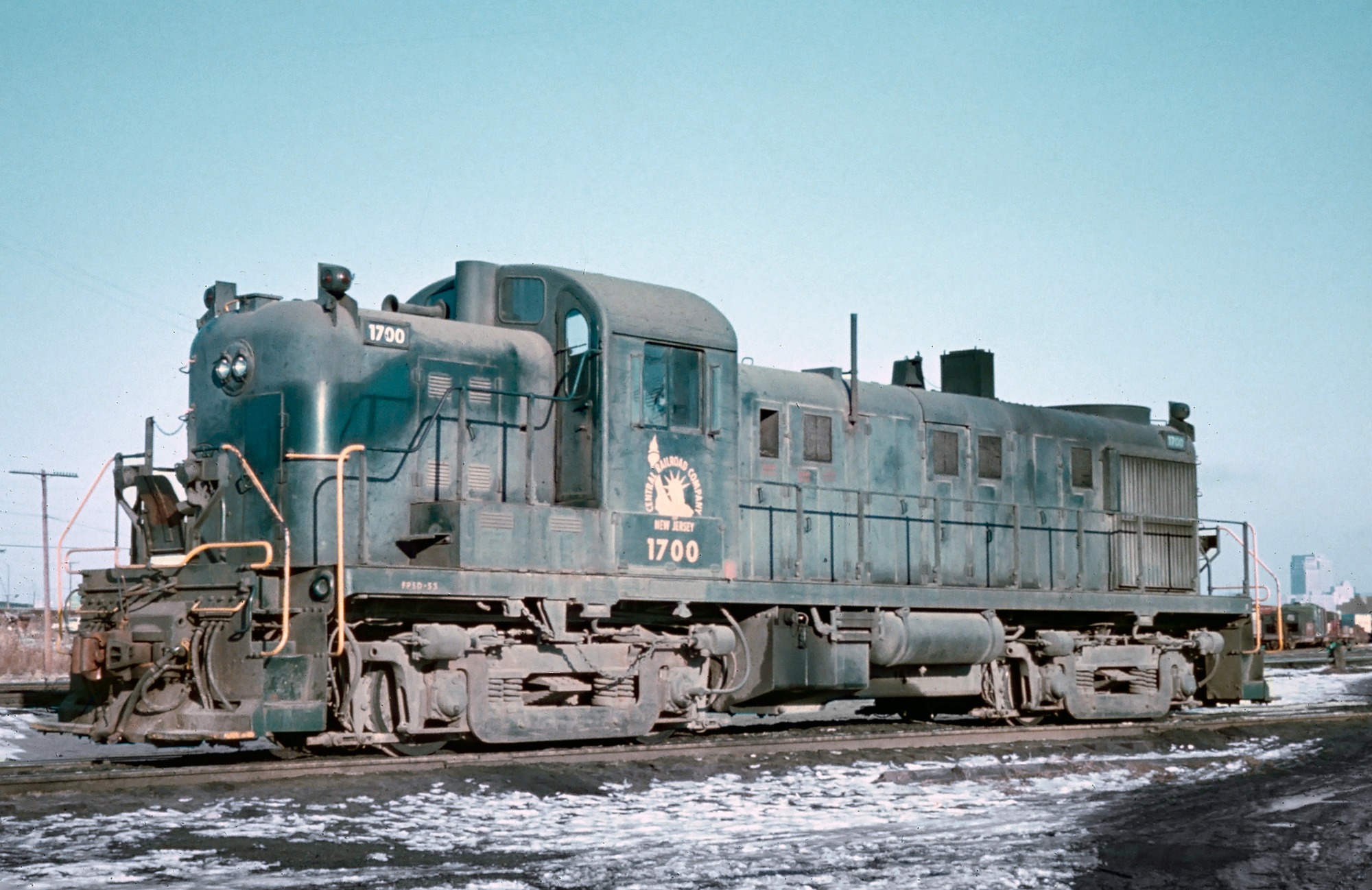 Jersey Central RS3 #1700 at Jersey City, New Jersey in the winter of 1970. American-Rails.com collection.
Jersey Central RS3 #1700 at Jersey City, New Jersey in the winter of 1970. American-Rails.com collection.This area of eastern Pennsylvania lay in the heart of anthracite country and numerous railroads could be found operating there which included the Lehigh Valley, Erie, Lackawanna, Lehigh & Hudson River, Lehigh & New England, Reading, Delaware & Hudson, Ontario & Western, and even the Pennsylvania.
In addition, cities like Easton, Scranton, Wilkes-Barre, and previously-mentioned Phillipsburg grew into robust manufacturing centers while Bethlehem was a steel-producing mecca.
Following the turn of the century, in 1901 the Reading took control of the CNJ, which lasted until 1976 and Conrail (the Reading, itself was acquired by the B&O in 1903).
This railroad was similar to the Jersey Central in that it handled large volumes of anthracite coal from the eastern Pennsylvania coalfields while also carrying considerable merchandise and commuter traffic from the New Jersey, Tri-State, and Philadelphia regions.
The CNJ remained a profitable system until the Great Depression and carried out several improvement projects prior to that time. Classic Trains Magazine notes that it put the first automatic semaphore signal into service in 1893 and upgraded the bridge across Newark Bay as a four-track, 1.4-mile drawbridge in 1926 to handle increasing demand.
At its peak, the Central Railroad of New Jersey operated 700 route miles clustered within a dense network that in total boasted some 1,900 track miles!
While the railroad was successful during its early years, as demand for anthracite waned after the 1920s and the impending Great Depression further decimated the business environment, the CNJ fell on hard times. It entered bankruptcy in 1939 and did not emerge until after World War II, in 1949.
It also struggled to deal with New Jersey's increasing tax burden while rising operating/labor costs coupled with declining patronage meant commuter and passenger trains were no longer profitable operations. The CNJ was a finely-tuned operation at the turn of the 20th century.
Its visionaries had comprised a system built for handling commuters and anthracite coal, which they believed would be a viable business virtually forever. Alas, they could never have predicted the rise of the automobile or falling demand for coal; ultimately, the railroad's busy years lasted but a few decades.
Schedule and Timetables (1940)
The Northeast’s traffic base shrank after World War II as manufacturing moved out of the region and ever-expanding highways pulled away short-haul freight. By the 1960s, the companies mentioned above were facing destitution; there were simply too many railroads and not enough traffic.
Roads like the Reading, LV, and CNJ were hit especially hard as they all relied heavily on anthracite, which was no longer profitable as demand had almost completely disappeared.
In a somewhat ironic twist, the CNJ actually grew during this period when it acquired segments of the former segments of the Lehigh & New England, totaling about 41 miles in Pennsylvania, which had shut down in 1961.
As Walter Kraus notes in his article, "Real Demise Of Rail Line Trailed Coal's Decline," from the August 24, 1989 edition of The Morning Call, the CNJ purchased this trackage for $10 million with the sale made effective on October 31, 1961.
These lines included Tadmor Yard at Bath, the Bethlehem Branch, the Martins Creek Branch, trackage around Catasauqua, and the former Panther Creek Railroad to Tamaqua.
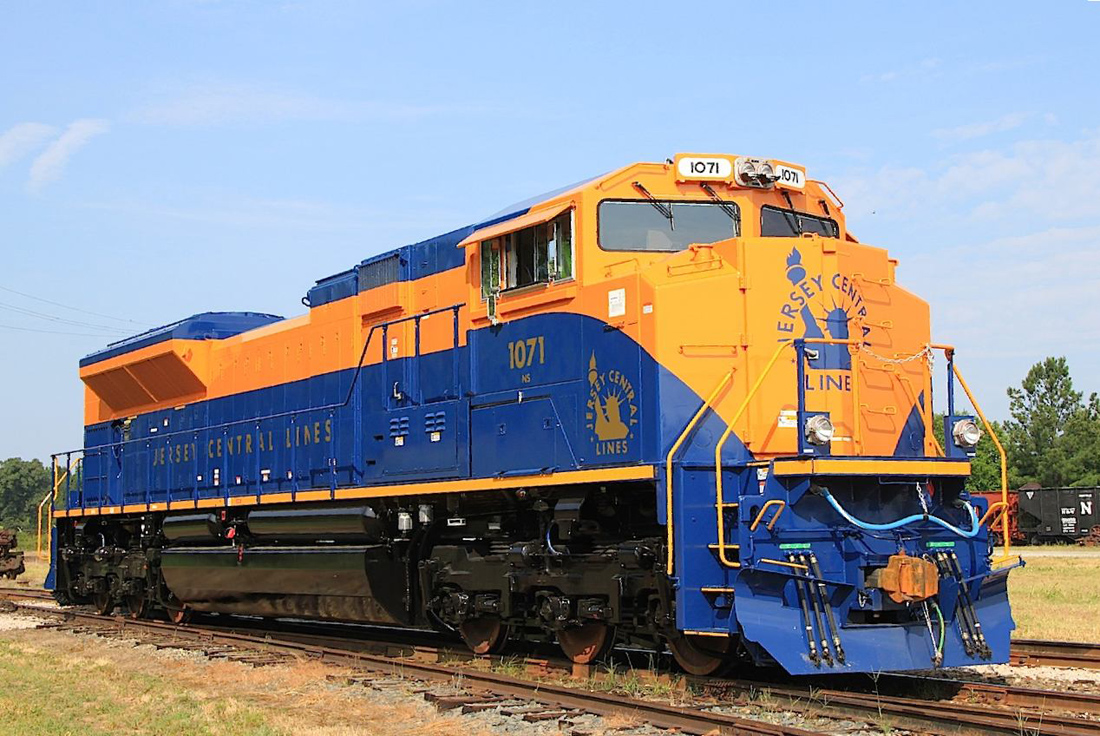 An example of the Jersey Central's early livery, now worn by Norfolk Southern heritage unit SD70ACe #1071. The locomotive is seen here during the Class I's 30th Anniversary celebration at the North Carolina Transportation Museum on July 3, 2012. Warren Calloway photo.
An example of the Jersey Central's early livery, now worn by Norfolk Southern heritage unit SD70ACe #1071. The locomotive is seen here during the Class I's 30th Anniversary celebration at the North Carolina Transportation Museum on July 3, 2012. Warren Calloway photo.Final Years
As red ink continued to flow the CNJ entered its final bankruptcy in 1967. That same year, New Jersey's Aldene Plan went into effect in an effort to curb the significant losses railroads were incurring from passenger/commuter operations.
This move saw a new connection built to the Lehigh Valley at Aldene allowing CNJ trains to reach PRR's Pennsylvania Station in Newark and eliminating service at Jersey City Terminal.
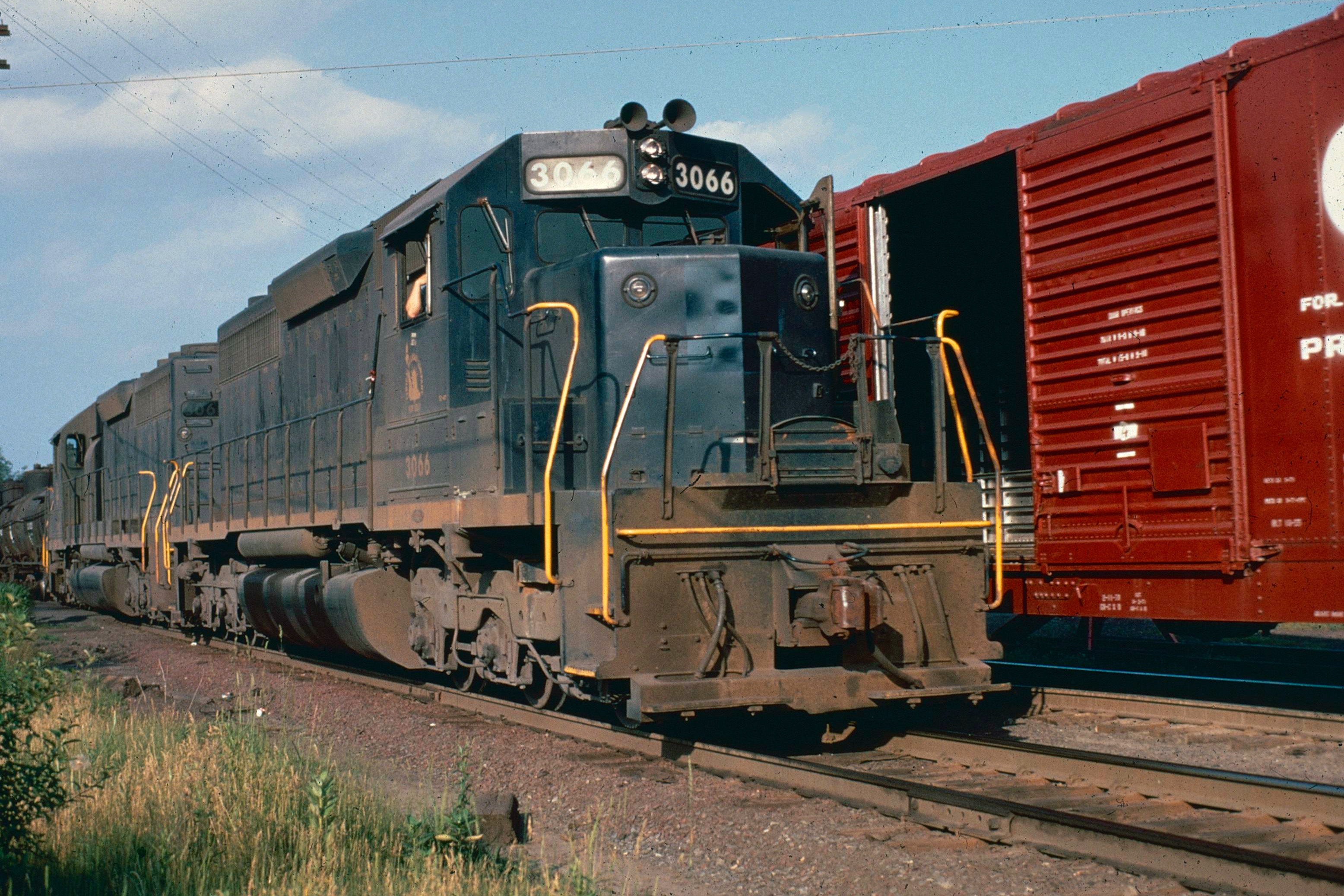 Jersey Central SD40 #3066 (ex-B&O #7487) and #3069 (ex-B&O #7490) lead a westbound freight through Ashley, Pennsylvania along Main Street on June 27, 1971. Author's collection.
Jersey Central SD40 #3066 (ex-B&O #7487) and #3069 (ex-B&O #7490) lead a westbound freight through Ashley, Pennsylvania along Main Street on June 27, 1971. Author's collection.With the closure of JCT, the Newark Bay Drawbridge also became redundant and was eventually razed by the U.S. Coast Guard during the 1980s.
In a last ditch attempt to reduce its considerable losses the CNJ embargoed all lines in Pennsylvania in 1972, which were picked up by the Lehigh Valley.
In the end, nothing worked and the railroad, which boasted perhaps the most patriotic of all railroad logos, Lady Liberty (a logo it acquired in 1944 when the company became known as the "Jersey Central Lines"), quietly disappeared into Conrail on April 1, 1976.
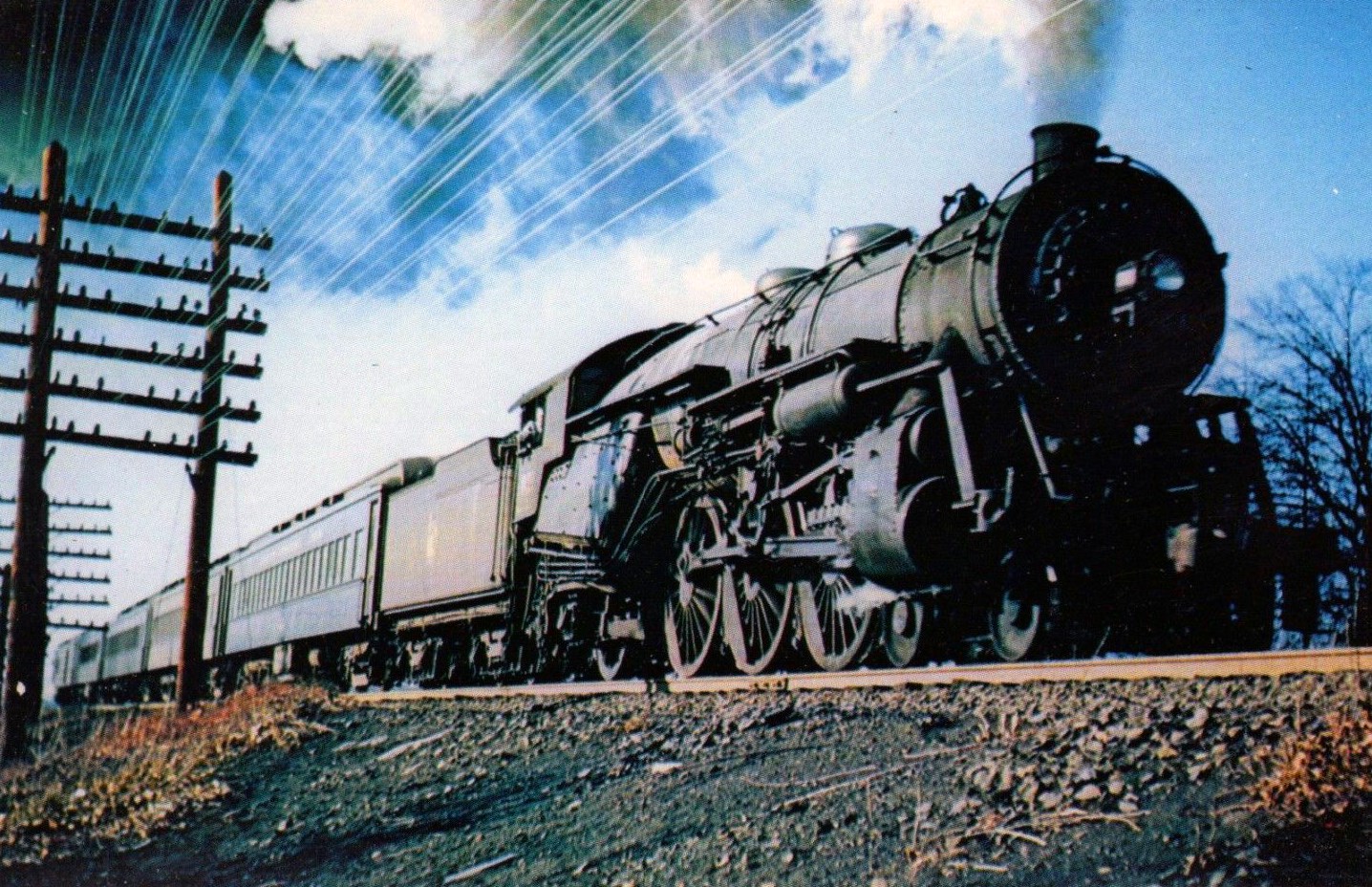 Jersey Central 4-6-2 #821 gets up to speed with a commuter run after just departing eastbound from the Netherwood Station in Plainfield, New Jersey on December 29, 1952. Joe Stark photo.
Jersey Central 4-6-2 #821 gets up to speed with a commuter run after just departing eastbound from the Netherwood Station in Plainfield, New Jersey on December 29, 1952. Joe Stark photo.The Jersey Central was, of course, a small railroad in comparison to most other classic systems. However, for her small size she held numerous achievements and feats.
In addition to those previously mentioned they include the first commercially successful diesel locomotive, The Blue Comet (the CNJ's most successful and famous passenger train connecting Jersey City with Atlantic City), and a four track main line that stretched from Jersey City to Raritan, New Jersey.
Passenger Trains
The Blue Comet: Jersey City - Atlantic City
Diesel Roster
American Locomotive Company
| Builder | Model | Road Number(s) | Serial Number | Completion Date | Notes |
|---|---|---|---|---|---|
| Alco | RS3 | 1564 | 80107 | 7/1952 | ex-Reading 489; became Conrail 5389 |
| Alco | RS1 | 1200-1204 | 78095-78099 | 6/1950 | - |
| Alco | RS1 | 1205 | 79234 | 9/1951 | - |
| Alco | RSD4 | 1601-1606 | 78745-50 | 11/1951-2/1952 | Sublettered for Central Railroad of Pennsylvania. |
Baldwin Locomotive Works
| Builder | Model | Road Number(s) | Serial Number | Completion Date | Notes |
|---|---|---|---|---|---|
| Baldwin | DR-4-4-1500 (B) | K, L, M | 73124-73126 | 11/1947, 7/1948-8/1948 | Sublettered for Central Railroad of Pennsylvania. |
| Baldwin | DR-4-4-1500 (B) | R, S | 73127-73128 | 9/1948 | Sublettered for Central Railroad of Pennsylvania. |
| Baldwin | DR-4-4-1500 (A) | 70-79 | 73114-73123 | 11/1947-9/1948 | Sublettered for Central Railroad of Pennsylvania. |
| Baldwin | DRX-6-4-2000 | 2000-2002 | 73060-73062 | 11/1946-1/1947 | A double-ended cab design for commuter service to the Jersey City terminal. Sublettered for Wharton & Northern. |
| Baldwin | DRX-6-4-2000 | 2003-2005 | 73750-73752 | 8/1948-9/1948 | A double-ended cab design for commuter service to the Jersey City terminal. Sublettered for Wharton & Northern. |
| Baldwin | RS12 | 1206-1208 | 75446-75448 | 1/1953 | - |
| Baldwin | RS12 | 1209 | 75698 | 1/1953 | - |
Budd Company
| Builder | Model | Road Number(s) | Serial Number | Completion Date | Notes |
|---|---|---|---|---|---|
| Budd | RDC-1 | 551-554 | 5919-5922 | 4/1954 | - |
| Budd | RDC-1 | 555-557 | - | - | - |
| Budd | RDC-1 | 558-561 | - | - | ex-NYSW #M1-M4 |
Electro-Motive Division
| Builder | Model | Road Number(s) | Serial Number | Completion Date | Notes |
|---|---|---|---|---|---|
| EMD | F3B | A, B, C | 4056-4058 | 7/1947 | Sublettered for Central Railroad of Pennsylvania. |
| EMD | F3B | D, E | 4059-4060 | 7/1947 | Sublettered for Central Railroad of Pennsylvania. |
| EMD | F7A | 10 | 10230 | 8/1950 | Leased from the B&O (#4503); built as B&O #243A |
| EMD | F7A | 11-12 | 15907, 15916 | 1/1952 | Leased from the B&O (#4576-4577); built as B&O #933 and #933A |
| EMD | F7A | 13-14 | 15918, 15910 | 1/1952 | Leased from the B&O (#4581-4582); built as B&O #937A and #9492 |
| EMD | F7A | 15 | 15911 | 1/1952 | Leased from the B&O (#4584); built as B&O #941 |
| EMD | F7A | 16-17 | 15913, 15922 | 1/1952 | Leased from the B&O (#4588-4589); built as B&O #945 and #945A |
| EMD | F7A | 20-22 | 9032-9033, 12615 | 7/1951 | ex-N&W #3689-3690, #3697; built as Wabash #689-690, #697 |
| EMD | F7A | 23-25 | 15038, 15040, 15047 | 1/1952 | ex-N&W #3703, 3#705, #3712; built as Wabash #703, #705, #712 |
| EMD | F7A | 26-29 | 17069-17070, 17072-17073 | 9/1952 | ex-N&W #3714-3715, #3717-3718; built as Wabash #714-715, #717-718 |
| EMD | F3A | 50-59 | 4046-4055 | 7/1947 | Sublettered for Central Railroad of Pennsylvania. |
| EMD | GP7 | 1520-1525 | 17098-17103 | 11/1952-12/1952 | Became Conrail #5676-5677, #5681, #5902-5904 |
| EMD | GP7 | 1526 | 17104 | 11/1952 | Wrecked on 9/15/1958, involved in the Newark Bay Bridge accident. |
| EMD | GP7 | 1526 (2nd) | 17106 | 12/1952 | Renumbered from 1528 (1st). |
| EMD | SD40 | 3061-3069 | 33161-33169 | 5/1967 | ex-B&O #7482-7490; became Conrail #6285-6292 |
Fairbanks-Morse
| Builder | Model | Road Number(s) | Serial Number | Completion Date | Notes |
|---|---|---|---|---|---|
| FM | H16-44 | 18 (2nd) - 19 (2nd) | 16L697-16L698 | 12/1952 | ex-B&O #6700-6701 |
| FM | H15-44 | 1500 | 15L6 | 3/1948 | Former demontrator #1500. Purchased by the CNJ in 9/1948. |
| FM | H15-44 | 1501-1513 | 15L15-15L27 | 1/1949-4/1949 | - |
| FM | H16-44 | 1514-1517 | 16L304-16L307 | 7/1950 | - |
General Electric/Ingersoll-Rand
| Model Type | Road Number | Date Built | Quantity |
|---|---|---|---|
| Boxcab 60T | 1000 | 1925 | 1 |
Steam Roster (Post 1900)
| Wheel Arrangement | Class (1919) | Class (1945) | Road Numbers | Quantity | Builder | Completion Date | Retirement Date | Notes |
|---|---|---|---|---|---|---|---|---|
| 4-6-0 | L5 | T28 | 150-166 | 17 | Brooks (Alco) | 1900-1901 | 1934-1952 | Camelback |
| 4-6-0 | L5a | - | 167-168 | 2 | Brooks (Alco) | 1902 | 1936 | Camelback |
| 4-6-0 | L5b | T32 | 169-174 | 6 | Brooks (Alco) | 1903 | 1936-1953 | Camelback |
| 4-6-0 | L5c | T32 | 175-184 | 10 | Brooks (Alco) | 1906 | 1934-1953 | Camelback |
| 2-6-2T | J1 | SU23 | 200-219 | 20 | Baldwin | 1902-1903 | 1935-1945 | |
| 2-6-2T | J1 | SU23 | 220-224 | 5 | Baldwin | 1904 | 1945 | Ex-Long Island |
| 4-6-4T | H1s | SU31 | 225-230 | 5 | Baldwin | 1923 | 1947-1950 | |
| 0-8-0 | E2s | 8553 | 295-304 | 10 | Schenectady (Alco) | 1923 | 1951-1955 | |
| 0-8-0 | E3s | 8561 | 305-314 | 10 | Baldwin | 1927 | 1952-1955 | |
| 0-8-0 | E4s | 8564 | 315-319 | 5 | Baldwin | 1929 | 1955 | |
| 0-8-0 | E4sas | 8564 | 320-324 | 5 | Baldwin | 1930 | 1955 | |
| 4-8-0 | K1 | TW40 | 430-480 | 51 | Brooks (Alco) | 1899-1901 | 1934-1948 | Camelback |
| 4-4-2 | P1a | - | 572-574 | 3 | Baldwin | 1902 | 1928-1930 | Camelback |
| 4-4-2 | P6s | A28 | 590-595 | 6 | Brooks (Alco) | 1901-1902 | 1946-1947 | Camelback |
| 4-6-0 | L3 | T26 | 600-630 | 31 | Brooks (Alco) | 1902 | 1934-1950 | Camelback |
| 4-6-0 | L3s | T34 | 631-635 | 5 | Baldwin | 1902 | 1946-1950 | Camelback |
| 2-8-0 | I5 | C44 | 650-665 | 16 | Brooks (Alco) | 1903, 1905 | 1934-1940 | Camelback |
| 2-8-0 | I4 | - | 675-684 | 10 | Brooks (Alco) | 1906 | 1948-1953 | Camelback |
| 4-6-0 | L6as | - | 750-759 | 10 | Baldwin | 1910 | 1953-1954 | Camelback |
| 4-6-0 | L7s | T38 | 760-769 | 10 | Baldwin | 1912 | 1948-1954 | Camelback |
| 4-6-0 | L7as | T38 | 770-779 | 10 | Baldwin | 1913-1914 | 1950-1956 | Camelback |
| 4-6-0 | L8s | T40 | 780-789 | 10 | Baldwin | 1918 | 1950-1954 | Camelback |
| 4-4-2 | P8 | - | 800-802 | 3 | Reading Shops | 1912 | 1938-1940 | Camelback |
| 4-4-2 | P7s | - | 803-805 | 3 | Reading Shops | 1912 | 1935-1937 | Camelback |
| 4-6-2 | G4s | P52 | 810-814 | 5 | Baldwin | 1930 | 1954-1955 | - |
| 4-6-2 | G1s | P43 | 820-825 | 6 | Baldwin | 1918 | 1948-1954 | - |
| 4-6-2 | G2s | P43 | 826-830 | 5 | Baldwin | 1923 | 1953-1955 | - |
| 4-6-2 | G3s | P47 | 831-835 | 5 | Baldwin | 1928 | 1950-1955 | - |
| 2-8-2 | M1s | M63 | 850-859 | 10 | Brooks (Alco) | 1918 | 1947 | A USRA design. |
| 2-8-2 | M2s | M63 | 860-870 | 11 | Brooks (Alco) | 1920 | 1947-1952 | - |
| 2-8-2 | M2as | M63 | 871-895 | 25 | Brooks (Alco) | 1922 | 1947-1955 | - |
| 2-8-2 | M3s | M63 | 896-915 | 20 | Alco | 1923 | 1947-1952 | - |
| 4-4-0 | - | - | 900 | 1 | Baldwin | 1903 | 1937 | Renumbered 999 in 1923. |
| 2-8-2 | M3as | M63 | 916-935 | 20 | Baldwin | 1925 | 1951-1955 | - |
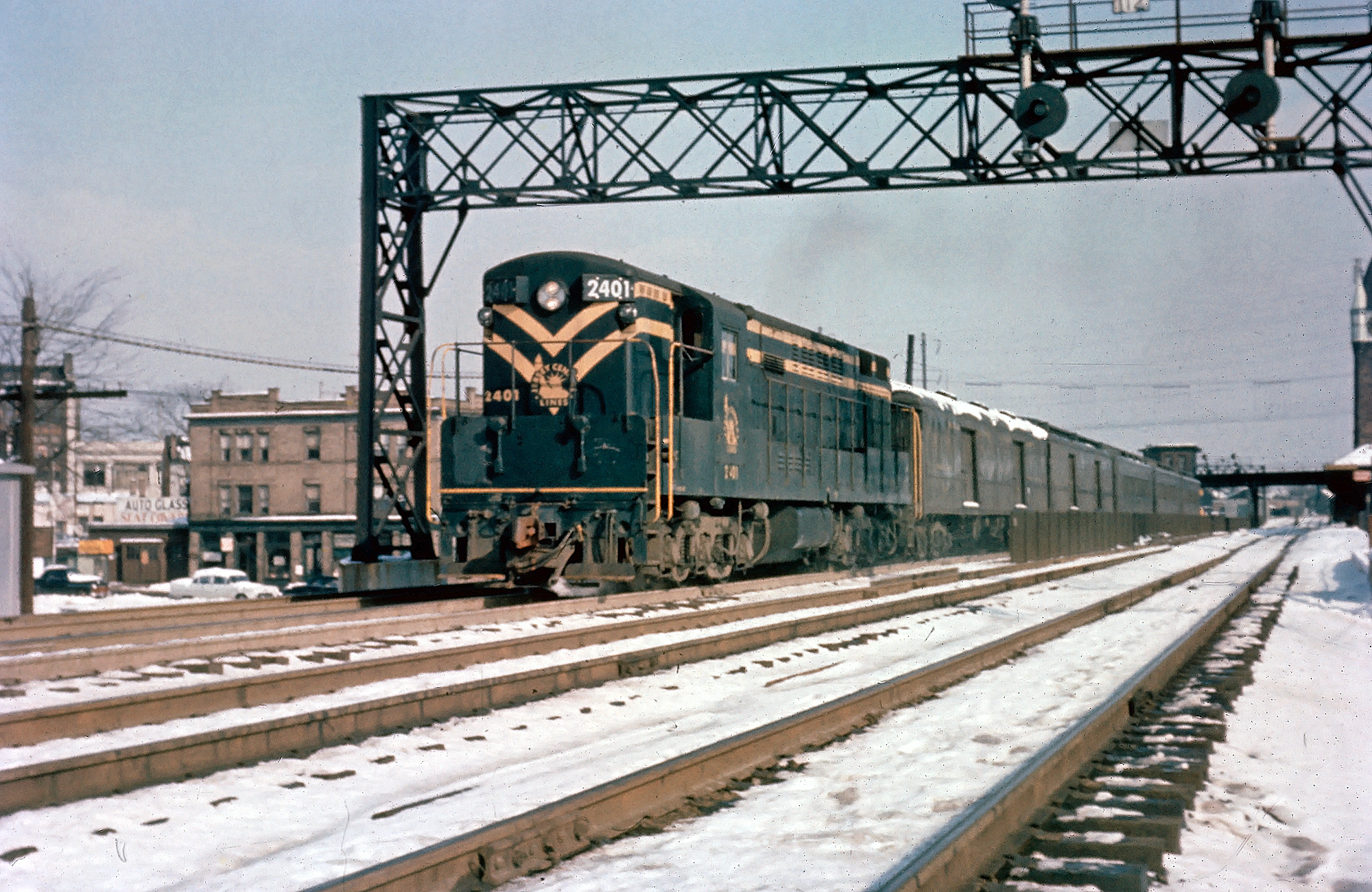 Jersey Central "Train Master" #2401 with a westbound train at Elizabeth, New Jersey, circa 1960. Meyer Pearlman photo. American-Rails.com collection.
Jersey Central "Train Master" #2401 with a westbound train at Elizabeth, New Jersey, circa 1960. Meyer Pearlman photo. American-Rails.com collection.Postscript
Sadly, the State of New Jersey and its politicians were not kind to the railroad's infrastructure, which would have offered a superb commuter corridor today.
Conrail saw little need for the CNJ lines and either sold or abandoned much of the property; its four-track main is completely gone while only sparse sections remain in use.
The Jersey City Terminal is still standing as a museum but has not seen a train call to her sheds since the controversial Aldene Plan went into effect.
In the end, many historians have felt the railroad was shredded by the state, milked through taxes and abandoned over time without realizing its potential to the Tri-State area.
Today, highways and interstates are choked with traffic as politicians try to find alternatives to ease the burden. While the Jersey Central is now but a memory a few of its lines still serve commuters while others handle some freight. Finally, segments of its Southern Division have been left in place and may see freight service again one day.
Contents
Lehigh & Susquehanna Division/Pennsylvania Division
Schedule and Timetables (1940)
Recent Articles
-
New Jersey Short Line Railroads: A Complete Guide
Apr 02, 25 10:29 AM
New Jersey remains an important state to railroading and several short lines operate there. Learn more about these systems here. -
New Hampshire Short Line Railroads: A Complete Guide
Apr 02, 25 10:17 AM
As one of the smallest states, New Hampshire is home to only a few active short lines. Learn more about these railroads here. -
Nebraska Short Line Railroads: A Complete Guide
Apr 02, 25 10:04 AM
Nebraska contains just a few short line railroads, largely concentrated in the handling of agriculture. Learn more about these systems here.
